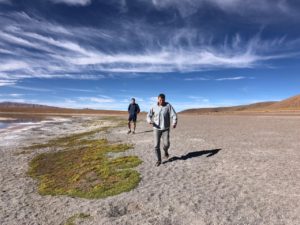
Bolivien
In Bolivien angekommen, bin ich zuerst nach Villamontes um die üblichen Arbeiten zu erledigen: Geld abheben und Telefonkarte kaufen. Geldwechseln beim Grenzübertritt ist zu teuer und deshalb wird das Restgeld an der Grenze „vertankt“. Die Banken sind hier noch heilig: bei der ersten ging der Automat nicht deshalb habe ich während der Mittagspause ans Fenster geklopft, da kam gleich die Security.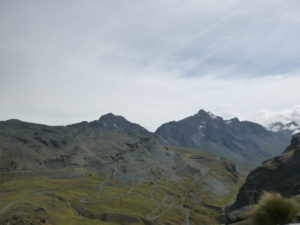
Bei der nächsten habe ich keine Wartenummer gezogen, im Kassenraum auf dem Handy Fotos angeschaut und wurde gebeten es auszumachen oder rauszugehen. Über die Frage nachdem „Warum“ und der Antwort „Security“ und meine Bemerkung „Bullshit“ konnten Sie nicht lachen, ich glaube die waren froh, als sich mich wieder loswaren.
Die ersten 100 Kilometer in Bolivien war die Strasse super, dann aber eine staubige, schnurgerade Piste bis zu den Bergen. Ich beschloß, zur Stadt Tarija zu fahren, habe es aber nur bis Entre Rios geschafft, da ich auf der Piste nur durchschnittlich 40 kmh fahren konnte.
In Entre Rios fand ich eine deutsche Familie, die ein kleines Hotel betreibt. Mit minimalen Mitteln haben die über die letzten 18 Jahre ein Haus, 2 Cabañas, Restaurant und Swimmingpool gebaut, alles schön ordentlich. Verbrachte kühle Nacht und der Mosquito-geplagte Körper konnte sich erholen.
Insektenspray hilft so gut wie gar nichts, egal welches.
Bin dann weiter und eigentlich sollte die Strasse asphaltiert sein, aber beide Navis haben mich auf einer Schotterpiste quer über die Berge gejagt. Habe mir Redbull besorgt, da ich mir hier keine Müdigkeit leisten kann. Die kleinen Kreuze auf winzigen Häuschen am Strassenrand sind Unfalltoten gewidmet.
Die schlimmsten Stellen wurden durch Streckenposten mit Walkytalky entschärft, die den Verkehr wechselseitig anhalten.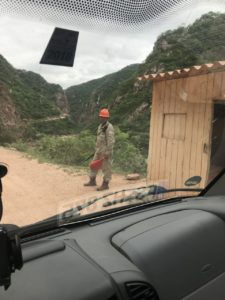
Teilweise musste ich Schneepflug spielen und mit meinem Unterboden den Kies wieder in die Spurrillen pflügen, es tat uns beiden weh, dem Auto und mir.
Die Strasse zwischen Entre Rios und Tarija war schon gefährlich, auch weil es geregnet hat und es sehr neblig war, allerdings wenig Verkehr, die waren wohl alle auf der Asphaltstrasse. Mir sind mehr Ziegen, Kühe, Schafe, Schweine und  Esel begegnet als Autos. Die Dose Redbull blieb dann im Kühlschrank, die Strecke hat genug Adrenalin produziert um mich am Einschlafen zu hindern.
Esel begegnet als Autos. Die Dose Redbull blieb dann im Kühlschrank, die Strecke hat genug Adrenalin produziert um mich am Einschlafen zu hindern.
Der höchste Pass war so 4200 Meter hoch, mir hat das nichts ausgemacht, bei Emmazwo habe ich aber festgestellt, dass der Motor ab 3000 Höhenmeter unter 2000 Umdrehungen keine Leistung mehr bringt, man muss höher drehen, was aber ausser mehr schwarzen Rauch kein Problem ist – Emmazwo macht die Sache wirklich gut.
Mit letztem Tageslicht in Tupizas angekommen, mit diversen Autostoppern unter anderem einem aus 4 Mann bestehenden Strassenbautrupp, die haben sehr intensiv gerochen, dass konnte auch die Klimaanlage nicht mehr wegschaufeln
.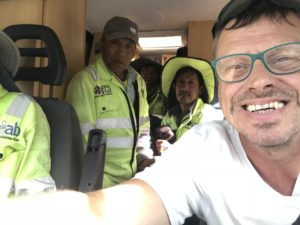
Hier in Bolivien muss man überall Papier ausfüllen und sich jede Quittung aufheben, jeder Strassenabschnitt, den man befährt wird im Zollpapier vermerkt und mit multiplen Stempeln und Belegen dokumentiert.
Sogar auf der öffentlichen Toilette bekommt man mit dem Toilettenpapier eine Quittung ausgehändigt.
Das Auto war ganz schön eingestaubt und so habe ich nach einer Waschgelegenheit gesucht. Die Handwäsche hat ca. 5€ gekostet und gab mir die Möglichkeit den Unterboden zu inspizieren, dabei musste ich leider feststellen, dass ich die Abdeckung der Lichtmaschine beim Aufsetzen gebrochen hatte. Deshalb habe ich dort nun eine Werkstatt gesucht, wo man mir geholfen hat und nach langer Suche auch einen neuen Keilriemen gefunden hat. Der Einbau kostete 8€, die Abdeckung wird repariert, während ich auf Jeep Tour durch die Salar de Uyuni und den angrenzenden Nationalpark gehe
.
Hatte Glück mit den anderen Teilnehmern, 3 Franzosen und ein Bayer, auch den Fahrer und die Köchin versteht man gut. Die Jeeptour führt uns durch Salzwüsten und zu Geysiren, wir baden in Vulkanwasser in sehr großen Höhen.
Auch am höchsten Punkt der Tour, auf 5000 Meter über Seehöhe, sind alle wohlauf. Wir trafen einen Allgäuer, der mit dem Fahrrad unterwegs ist, weil aber der Sand so tief ist, konnte er sein Rad schon seit Tagen nur noch schieben. Ich hatte Befürchtungen, dass von meiner Embolie noch Probleme übergeblieben sind, daher bin ich auf 5000 M mal versuchsweise 200 m zum Auto gelaufen und bin nicht kollabiert.
Auch ich kenne jetzt den Unterschied zwischen Alpaka, Lamas und Vikunas.
Wir haben in der Salar de Uyuni verrückte, lustige Fotos gemacht – die anderen sind ähnlich schräg drauf wie ich.
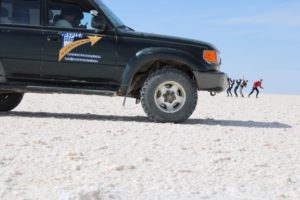
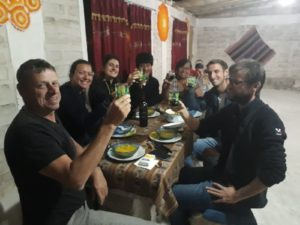
Hier im Süden von Bolivien sind die Bergwelt, die Salzwüsten und die Lagunen unbeschreiblich, die Menschen sind allerdings etwas reserviert, man braucht Geduld, dann aber wird es schon.
Haben auch in Salzhostel übernachtet, alles ist aus Salz.
Réné, unser Fahrer, hat jetzt zum Dank die erste von 3 Würth-Sonnenbrillen von mir bekommen, denn er und seine Frau als Köchin haben uns eine unbeschreibliche Tour geboten.
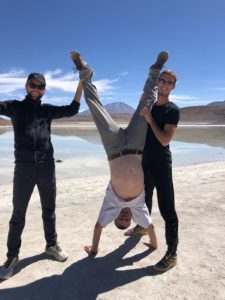
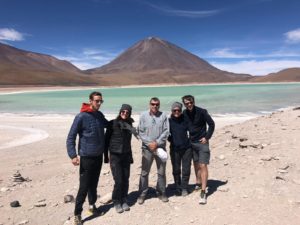
Auto in Tupiza repariert, für 13€. Die Geräusche kommen vom Klimakompressor, der wird mich wohl irgendwann verlassen.
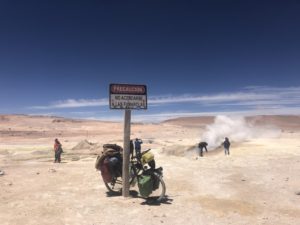

Auf dem Weg nach Sucre wurde ich von einer hübschen jungen Frau angehalten, Sie und ihre Mutter müssten nach Potosi, es gäbe keinen Bus.
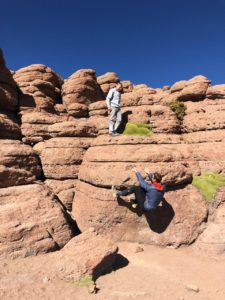
Die ersten 100 km waren eher ruhig, die Bolivier sind reserviert (wen wundert`s, zuerst haben die Weißen ihnen das Gold geklaut, dann die Kultur und jetzt die Bodenschätze).
Dann begann so langsam eine Konversation: Mutter fährt mit Schwester von Potosi nach Santa Cruz (12 h im Bus) um Verwandte zu besuchen. Also fahren wir nach Potosi, und als die Konversation in Gang kommt, erfahre ich, dass die junge Frau auch mitwollte, aber Kreuzweh und Magenprobleme hat. Etwas später, als wir mehr Vertrauen zueinander gefunden haben, werden aus den Schmerzen Schwangerschaftsbeschwerden.
Die einäugige Mutter spricht zwar angeblich Spanisch, aber nicht mit mir, mit ihrer Tochter spricht sie nur Quechua. Die Familie ist groß, 15 Kinder, und ein Teil wird jetzt besucht.
Kurz vor Potosi, nach einigen Telefonaten mit der Schwester, die am Busterminal in Potosi wartet plötzlich: „change of plan“. Der Tochter im Auto geht’s besser, sie hat Medizin gegen die Übelkeit genommen und möchte schnell nach Hause, einige Sachen packen und mitfahren. Während die Tochter die Sachen packt, setzt sich die Mutter auf die Strasse und der weite Rock schützt vor Blicken während Sie sich erleichtert.
Es dauert ewig bis die Sachen gepackt sind, wir auf zum Busterminal. Viel zu spät, wir ändern den Plan und fahren zum Friedhof, denn dort kommt der Bus vorbei. Als wir dort angekommen sind, ist der Bus weg und die Schwester steht auf der Strasse. Nächster Plan: zum Busterminal und Tickets zurückgeben, und dann auf nach Sucre. Da die Tickets aber nicht zurückgegeben werden können, erfolgt eine erneute Planänderung: Busverfolgung! Leider hat der Bus schon 30 Minuten Vorsprung…
Also, Schwester eingeladen und Vollgas nach Sucre, 20 Kilometer vor Sucre erklären mir die Damen, dass sie nicht wüssten, wo die Bushaltestelle ist. Die Internetsuche muss unterbrochen werden, da die Pillen nicht mehr wirken, aber zum Glück ist eine Plastiktüte zur Hand.
Die Tüte geht mit Inhalt über Bord, meine Feuchttücher werden gerne genommen. Ich kann gerade noch verhindern, dass sie auch aus dem Fenster fliegen. Die Suche nach der Bushaltestelle im Internet bringt keinen Erfolg, viel Diskussion in Quechua und mein Sprit geht auch zur Neige.
Was also tun? Ich habe noch für vielleicht 20 km Diesel und wir sind bald in Sucre – plötzlich viel Lachen und Schreien von Damen: wir haben den Bus eingeholt!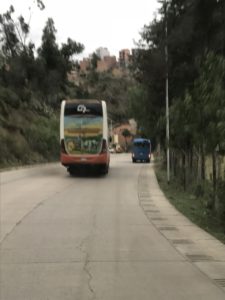
Die Bushaltestelle liegt auf der anderen Stadtseite, also mache ich schonmal einen Plan für danach: Mit Taxi 5 l Sprit holen, etc., zu allem Überfluss springt auch noch die Schiebetür auf und die Schwestern verstehen den Entriegelungsmechanismus nicht, also alles sichern und mit offener Tür hinter dem Bus her, der hält plötzlich genau gegenüber einer Tankstelle, welch ein Glück.
Es bleibt kaum Zeit zur Verabschiedung und der Busfahrer bedankt sich sogar! Die Tankstelle gegenüber ist eine der wenigen in der Stadt und deshalb total überlaufen. Den Warteneden wird aber umsonst Kaffee und Erfrischungsgetränke serviert.
Der Sprit für Ausländer kostet 9 Boliviar, für Inländer 3,8. Tipp von Mitcamper: Tankstelle ohne Computer suchen und verhandeln, 6 Bolivar seien machbar. Bilder machen strikt verboten.
Dann zum Stellplatz „Felicidas und Alfredo“: ein 70-jähriger Professor von der Uni, der in der Gartenlaube Elektromotoren neu wickelt.
Wie bei jedem Haus, wird auch bei Campern umgebaut. Der Verhau in meinem Bad stört mich und ich habe einen Dachgepäckträger gefunden, also kommen die Sachen, die ich nie benötige, wie Vorzelt etc. jetzt aufs Dach.
Die Montage war schwierig. Die Firma, die Dachgepäckträger montieren soll hat weder Gewindeschneider noch eine Stehleiter. Ich habe dann noch mit meinem Voltmeter die Lichtprobleme eines anderen Kunden gelöst. Die waren erstaunt über die Menge an Werkzeug, die ich mitführe.
Am letzten Abend in Sucre ging ein schweres Unwetter mit großen Hagelkörnern nieder und ich hatte Angst um meine Solarpanels. Durch die Dachluke hat es dann ganz viel Wasser gedrückt, aber im Gegensatz zum Nachbarn hatte ich keine sonstigen Schäden.
Angst um meine Solarpanels. Durch die Dachluke hat es dann ganz viel Wasser gedrückt, aber im Gegensatz zum Nachbarn hatte ich keine sonstigen Schäden.
Die Verlustliste muss um eine Softshelljacke verlängert werden, habe sie wahrscheinlich im Cafe hängen lassen. „so etwas hängt nicht lange“, sagte mir die Besitzerin. Zumindest war nichts in den Taschen, vermisse nichts.
Dann nach Cochabamba, was auf etwa gleicher Seehöhe wie Sucre liegt. Emmazwo und ich mussten aber einen 3700 m hohen Pass überqueren, mittlerweile ein Kinderspiel für uns beide.
Wieder Notfall: Mutter mit Kind wollen nach Aiquile, denn dort gibt’s ein Krankenhaus. Verständigung ist sehr schwierig, aber nach einer Weile geht es besser. Sie ist Mutter von 9 Kindern, das kleinste (etwa 10 Jahre) hat starken Husten und ist etwas apatisch. Habe dann die beiden vor das Krankenhaus gefahren und als ich das gebotene Geld strikt abgelehnt habe waren sie sehr froh.
Leider musste ich feststellen, dass sich meine Klimaanlage verabschiedet hat. Werde dann mal in Chile nachschauen lassen, der Sommer liegt ja noch vor uns.
In Cochabamba angekommen, habe ich nur noch gekocht und bin ins Bett gegangen, denn der Campingplatz lag zuweit ausserhalb.
Am Morgen dann nach La Paz weiter, wobei sich meine beiden Navis einen Streich erlaubt und mich zu einem Fluss gelotst haben: zweimal! Ich fands nicht so gut und habe geflucht, denn dass bedeutete 30 km Staubfressen. Das iphone scheint das persönlich genommen zu haben und hat sich ausgeschaltet. Dann eben konventionelle Navigation mit Fragen. Endlich habe ich eine Brücke gefunden. Bammel hatte ich dabei schon, denn die Einheimischen waren steckengeblieben und Emmazwoist größer und schwerer und ich hatte keinen Einweiser. Zum Glück ging alles gut.

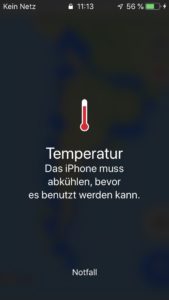
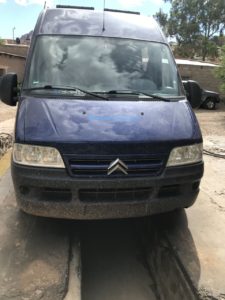
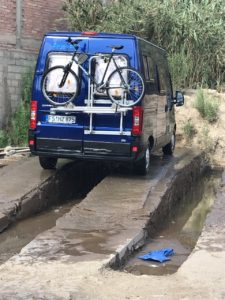
Über die Berge viel Staub gefressen, oben am Berg auf 4300 m gibt’s eine provisorische Tankstelle, der Diesel kostet hier 5 Bolivar für alle. Habe 20€ gespart.
Mit dem letzten Sonnenlicht im schönen Colibri Camp in einem Tal etwas südlich von La Paz angekommen: fix und alle, nur noch Essen und Schlafen.
In einem Reiseführer hier habe ich gelesen, dass man La Paz mit einer großen Schüssel in der spiralenförmig nach unten Ziegelbauten geklebt sind vergleichen kann. Die Häuser werden nicht verputzt, da sie so als nicht fertig gelten dann weniger Steuern zu zahlen sind.
Wurde auf dem Zentralplatz von Tourguides angesprochen, ob ich nicht eine Tour mit den Telefericos für 50 Bolivianos machen will. 3 Stunden mit bezaubernder Kommunikationsstudentin, habe viel erfahren, bin jetzt Superfan von den Seilbahnen hier.
,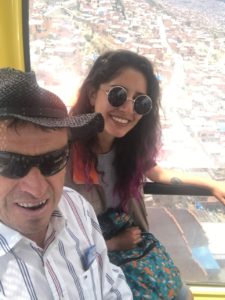
Waren auch in El Alto auf über 4000 m, dem größten Markt in Südamerika. Hier bekommst du alles! Die kurioseste Sache war ein getrockneter Lamafötus als  Opfergabe. Gibt dann noch eine Straße mit Brujas, den Hexen, hier kann man Zeremonien buchen, wie z. Bsp. Opfergaben zum Wohl bestimmter Personen, aber auch Verfluchungen. Habe keines von beiden gemacht, bin aber noch zwei Tage hier.
Opfergabe. Gibt dann noch eine Straße mit Brujas, den Hexen, hier kann man Zeremonien buchen, wie z. Bsp. Opfergaben zum Wohl bestimmter Personen, aber auch Verfluchungen. Habe keines von beiden gemacht, bin aber noch zwei Tage hier.
Da meine französischen Freunde jetzt zwei Tage voraus sind und total begeistert von der Bergab-Radtour an der Carretera de la Muerte waren, habe ich das auch gebucht, für Emmazwo ist das nichts, die darf rasten.
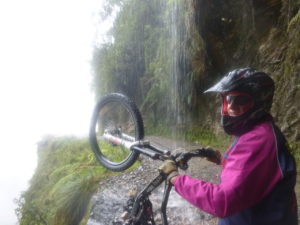
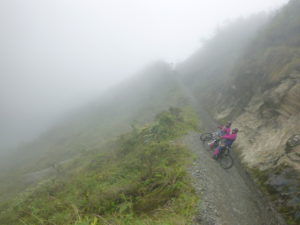
Eigentlich heißt die Tour „Carretera del la Yungas“ und führt von 4400 m auf 1250 m, auf einer Länge von etwa 50 km, die ersten 20 km auf Asphalt, dann auf Schotter. Der Tourguide hat viele Fotos gemacht und uns regelrecht vor den Schluchten plaziert. Die Strecke ist seit 2006 stillgelegt, mit dem Auto möchte ich sie nicht fahren.


Da es keine Ruhezeiten-Verordnung für Lkw-Fahrer gibt, fahren die ewig lange Zeiten und halten sich dabei mit Koka und bolivianischem Whisky wach, was zu schweren Unfällen führt. Diese Wochegab es bereits 6 Tote.
Ich bin froh, den Moloch La Paz verlassen zu können, denn es ist sehr anstrengend, die dünne Höhenluft ist auch noch sehr mit Autoabgasen verschmutzt.
Generell ist Bolivien ein automordendes Land: Emmazwo hat hier sehr gelitten. Seit 4 Wochen bin ich auf Höhen zwischen 3.300 und 5000 m, der Körper stellt sich langsam darauf ein, aber es kommt immer wieder zu Atemnot und Beklemmung. Ich habe in einem Leitfaden für Bergsteiger gelesen „hoch steigen, tief schlafen“, soll heissen zum Schlafen immer in tiefere Höhen. Bin dann immer zum schlafen auf mindesten 3.500 runtergefahren und fühlte mich danach viel besser.
Sollte ich wieder nach Bolivien kommen, werde ich einige Touren machen, aber dann bin ich besser vorbereitet.
Bolivien ist ein armes Land, sehr günstig für uns. Seit Evo Morales wird viel gebaut, die Strassen sind schon viel besser, in la Paz gibt es ein Netz von Seilbahnen der österreichischen Firma Doppelmeier, aus diesem Grund kennt hier jeder Österreich.
Evo Morales bestreitet jetzt seine dritte Amtszeit (laut Verfassung sind nur zwei möglich) und möchte noch ein viertes Mal gewählt werden. Für mich ist er etwas zu präsent, auf jedem Plakat, an jeder Sesseliftkabine ist sein Foto. Es wird wohl auch andere Demokraten in Bolivien geben.
Die Verständigung mit den 60% Indigenen ist schwierig, mit den 26% Mestizen klappt’s ganz gut. Die 14% rein Weiße verstecken sich in abgesperrten Wohnvierteln und elitären Clubs.

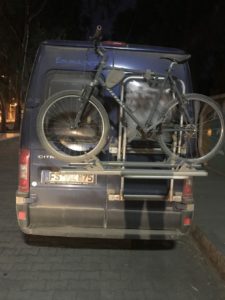
Ich war immer zum Golfspielen im Golf Club La Paz: sehr elitär – der höchste Golfplatz der Welt. Aber es stimmt, die Bälle fliegen weiter. Habe einen Golfball unter Anleitung meines Lehrers Alberto in die Wand der Driving Range auf 300 m Entfernung gedroschen.

Werde den Bolivienblog hier beenden, es geht weiter zum Titicaca See, aber der heilige See bekommt ein eigenes Kapitel.

Bolivia
I arrived in Bolivia and immediately went to Villamontes to get some things done. I needed to draw some cash and buy myself a Bolivian sim card. Exchanging money gets quite expensive here so all of it goes into the fuel costs at the boarder.
The banks are still super ‘sacred’ here. The ATM wasn’t working so I knocked on then office window. Apparently I knocked during their lunch break and security immediately approached me. I went to the next bank and whilst waiting, I pulled out my phone to look at photos. I was asked to switch it off or leave. When I asked why, security was already on their way to me and my immediate response was “bullshit” (this was not received well) I think they were glad when they finally got rid of me.


The first 100kms on the road were super with great driving conditions. After this came a dust road, but relatively straight towards the mountains.
I decided to drive to the city Tarija but unfortunately only made it to Entre Rios, the dust road came with a maximum of 40km/hI found a German family in Entre Rios that own a small hotel that they started working on around 18 years ago, with minimal resources. Today they have a house, 2 Cabañas, a restaurant and a swimming pool. I spent a nice cool night there, even managed to give my mosquito attacked body a break. Insect spray hasn’t helped in the least, doesn’t even matter how many different types I’ve tried
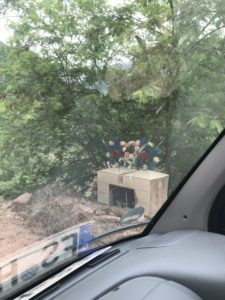

I drove on, on what was supposed to be a tarred road, but both navigation systems led me onto unpaved, dirt roads. I got myself some red bull, tiredness is something I cannot afford. There were little crosses along the road, identifying all the places where people have tragically died- something quite sad to see.
The worst parts would be controlled by ‘marshals’ with walky-talkies, who would then take turns to stop drivers.
Sometimes I had to play snow plow and use the underbody of the car to get the gravel back into the ruts, it hurt both me and the car…
The road from Entre Rios to Tarija was very dangerous. It had just rained and there was a heavy fog. There wasn’t much traffic though, most others were probably driving on the paved roads. I encountered more cows, goats, sheep, pigs and donkeys, than I did other cars. Therefore, the red-bull stayed in the fridge, this environment produced enough adrenaline to keep me up for a while.
The highest pass that I drove was at 4200 above sea level, it was pretty alright for me but I noticed that with Emmazwo, over 3000 meters you can’t do
I arrived in Tupizas just as darkness rolled in, after very diverse pull overs along the way, which included a very intensive group of 4 guys, smelling quite intense as well (the air conditioning couldn’t get that smell away quick enough)
In Bolivia, you have to constantly sign papers and take every receipt, every meter of every road that you drive is written down in the toll papers with multiple stamps and notes. I went to a public bathroom and even got a receipt for the toilet paper they handed out! 
The car was incredibly dusty, so I went on a search for a car wash. A hand car wash costed around 5€. This let me inspect the underbody of the car, I was unhappy to discover that the cover of the alternator had been broken. I found a repair shop that replaced the fan belt, the replacing of it cost a super 8€, and I even got the cover of the alternator fixed. While it was being repaired, I decided to do a Jeep tour through Salar de Uyuni and the boarder lying national parks. I was lucky with the other. participants, 3 French guys and one from Bavaria. The driver and cook were also quite easy to understand
Here, we drive through salt deserts and to experience warm waters, you can bath in volcano waters, at high altitudes.
We also went up to the highest spot above sea level, 5000m! I met a german guy who was travelling with his bike that he has been pushing along for days, due to the depth of the sand.
I was scared that I was suffering a bit from the aftermath of my previous embolism. I jogged 200 meters to the car at 5000 meters above sea level and I did’nt collapse, so I think I should be fine!
I finally know the difference between Lamas, Alpacas and Vicunjas.
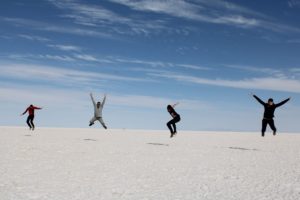
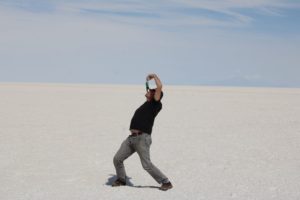
We took some crazy photos at Salar de Uyuni, the others are just as fantastically weird as I am. The landscapes of southern Bolivia are absolutely astounding; the mountain ranges, the lagoons and the salted deserts are indescribable. The people are a bit different, you need some patience but after a while they become better. I even stayed a night at a salt hostel, everything is made out of salt!
Rene, our driver, was the first to receive one of my three pairs of Würth sunglasses. Him and his wife (our cook) gave us the most wonderful tour.
I had the car repaired in Tupiza for 13€. Apparently the sounds are coming from the air-conditioning compressor, it will soon die on me.
On the way to Sucre, I was stopped by a very pretty lady and her mother- they were on their way to Potosi and there wasn’t a bus they could take. The first 100kms were rather quiet, the Boliviens are reserved.. For what its worth, white people firstly stole their gold, then their culture and then the treasures of their land. After a while we fell into conversation. Her mother is travelling to Potosi, where she will meet with her sister to take a 12 hour bus to Santa Cruz to visit family.
As we continued talking, I found out that the young lady also wanted to go with but couldn’t as she had bad back pain and stomach aches. A bit later, after we found trust in one another, the pains were described as pregnancy symptoms.
Her one eyed mother apparently speaks Spanish, just not with me. She speaks only ‘Quechua’ to her daughter. She has a very big family of 15 kids that are waiting for them in Santa Cruz.
Just before Potosi, there was a quick change of plan. After numerous phone calls to the sister that is currently waiting at the bus terminal, the young lady has no more pain. She has taken medication for it all and feels totally well, enough to travel with. She wanted to quickly go home to pack some things. While she was packing her things, her mother sat down on the street. Safe to say, her wide skirt shielded eyes of bystanders while she relieved herself…
It took forever for her to pack her ‘few things’, so when we arrived at the terminal, the bus was already gone. Another quick plan change, and off to the graveyard- the bus will drive past here. We got to the graveyard, the sister was standing on the street and the bus was gone. Plane change- off to the terminal, return the tickets and then we were on our way to Sucre.
The tickets couldn’t be returned so another Plan Change- chasing down that bus! Our disadvantage, the bus had a 30 minute head start. So we picked up the sister and I put the pedal to the metal to catch the bus. The ladies informed me that they didn’t actually know where the bus station was, and did so 20 kilometers before arriving in Sucre. The internet search was aborted when the medication for nausea was suddenly ineffective, thank god a plastic bag was within reach. The full plastic bag was throw out the window before eagerly using up my wet wipes, which I lucky was able to stop from flying out as well. The earlier internet search for the bus station wasn’t successful which caused a big discussion in Quechua with petrol running low. What could I do? Around 20km diesel left, almost in Sucre with no sense of direction and suddenly there was an explosion of laughter: we had caught up to the bus!

The bus station was on the other side of the city, so I quickly drew up a plan in my head. I’d fetch 5 litres of fuel with a taxi. To make matters worse, the siding door jumps open and the sisters didn’t understand the locking mechanism, so quickly pack everything safely and chase the bus with an open door. What are the odds, the bus stops directly opposite a petrol station!
There was barely time for goodbyes, the bus driver even thanked me. The petrol station was one fo the few in the city, very run down though. However, it serves its purpose of fuelling the car and serving coffee and refreshing drinks.
The petrol costs 9 Bolivian boliviano for tourists and 3,8 bolivianos
For locals. A tip from camping friends was to look for a petrol station without computers so that you can bargain. 6 bolivianos was the best I could get and taking pictures is definitely not allowed.


At the camping place I met Felicidas and Alfredo, he is a 70 year old professor at the university who was working with new electrical motors int he gazebo. Like with every house, campers also get renovated and updated. The mess in my bathroom is getting to me. I found a roof rack that allows me to have some storage on the roof of Emmazwo, everything that I do not use too often will go up there. The mounting of it was difficult because I had no ladder or cutters. I then moved onto the Light problem of another ‘customer’ who was shocked as to how many tools I have.
Most least evening in Sucre brought very bad weather. It was hailing, very heavily and with quite huge rocks. I was afraid that there was going to be damage to my solar panels. Quite an amount of water was getting pushed through cracks in the car, but the damage was nothing compared to that of neighbouring campers. 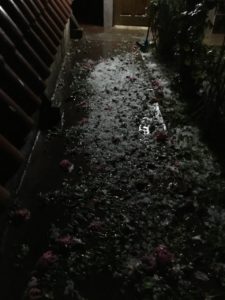
I need to add to my list of losses. I lost my soft shell jacket, I think I might have left it in the coffeehouse. The owner told me that things like that will not hang there for long, thank god I didn’t leave anything in the pockets- I’m not missing anything.
Further I drove to Cochabamba which lies at about the same sea level as Sucre. Emmazwo and I did however have to drive up a 3700 meter pass to get there, at this point it’s not funny anymore.
I again picked up some hitchhikers, a mother and her child were on their way to Auquile to get to the hospital. There was a language barrier between us so little understanding, but eventually we got it. She was a mother of 9 children, the youngest being 10 years old with a very bad cough. I dropped them right in front of the hospital and I think they were quite glad when I refused the money they offered.
Sadly I learned that my air-conditioning has said a farewell, I’ll have to get the car properly checked in Chile seeing as the summer is still ahead of me.
All I did in Chochabamba was cook some food and then straight to bed- the camping site was too far outside of the city.

The next morning, I made my way to La Paz, both my navigation systems pranked me and led me to a river. This caused some bad language on my end because this involved a 30km long dirt road. The iPhone took this personally and just switched itself off. The other GPS was an effort to sort out but eventually I found some bridges. Already had some stress because locals had gotten stuck already, Emmazwo is much bigger and heavier so this was a bit daunting but everything went fine.

Drove through dust over the mountains, reaching about 4300m. Up there, there was a petrol station for priority where the diesel costs 5 Bolivianos for everyone. I saved about 20€!
I arrived at Colibri Camp in a town just south of La Paz just as the sun was setting. Completely exhausted, I quickly ate and went straight to bed.
I was reader a travels guide on La Paz, and it’s true that the houses here are not plastered so they are considered ‘unfinished’- thus less taxes need to be  paid. Whilst looking around the city centre, I was confronted by tour guides who offered a tour to me for 50 bolivianos. 3 hour later, I was the biggest fan of the Bolivian cable ways and had a new friend, a very charming communications student.
paid. Whilst looking around the city centre, I was confronted by tour guides who offered a tour to me for 50 bolivianos. 3 hour later, I was the biggest fan of the Bolivian cable ways and had a new friend, a very charming communications student.
El Alto is the biggest market in South America, situated at 4000 meters above sea level. Here, you can buy absolutely anything and everything: dried lama foetus! There is 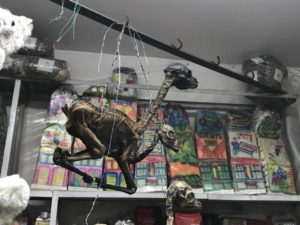 even a street with Brujas (witches) that you can book a ceremony with. For example, you can book for the bettering of someones soul or even install curses. I did not do either but I am still here for two days…
even a street with Brujas (witches) that you can book a ceremony with. For example, you can book for the bettering of someones soul or even install curses. I did not do either but I am still here for two days…
The French friends I made here were so impressed with the bicycle tour they did down the Carretera de la Muert. I booked this one to try it out, it’s time for Emmazwo to rest.


The tour is actually called Carretera del la Yungas and goes from 4400 meters to 1250 and is about 50km long. The fist 20km are in tar and then on a dirt road. The tour guide took lots of photos are let us stop a lot to look at the gorges. The exact track has been closed since 2006, it’s something I’d never want to actually drive a car on.
Throughout Europe, there’s lots of resting places for truck drivers so that they can have their breaks when driving long distances. They do not have that here, so the drivers are forced to drive much longer, staying awake on only coke and Bolivian whiskey. This obviously leads to unsafe driving situations, in the last week there have been 6 deaths.
I’m quite happy to be leaving Moloch La Paz, the little air up here is pretty much completely polluted.
Bolivia seems to be the worst country to be driving through, Emmazwo has suffered too much. I’ve been at around 3300-5000 meters above sea level for 4 weeks now. The human body gets used to it after a while, but every now and again it takes a bit of laboured breathing.
I read a guide for people travelling the mountains and it states that you should always descend a but more to lower heights when wanting to sleep.
If I ever return to Bolivia, I’ll do a lot more tours but definitely organise a bit better.
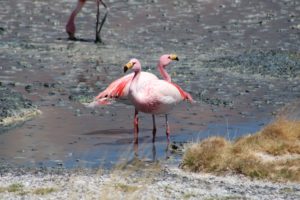
Bolivia is a very poor country, a super cheap place for us tourists. Ever since 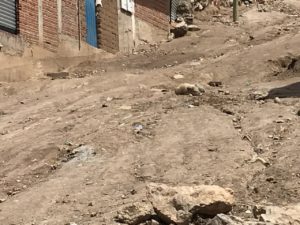 Evo Morales came into power, things have gotten better. The streets are much better and there is an Austrian cable way company operating a bit in La Paz with a whole net of cableways. Everyone seems to know Austria here.
Evo Morales came into power, things have gotten better. The streets are much better and there is an Austrian cable way company operating a bit in La Paz with a whole net of cableways. Everyone seems to know Austria here.
Evo Morales is going is in his third term in power (technically only two are allowed) and still wants to be voted for a fourth one. His posters are everywhere promoting him, surely there are other Bolivian politicians!
Communicating with the 60% local people is difficult, the communication with the 265 of Mestizo is much better. The 14% of white people are hiding in safe living estates and elite clubs
I golfed at the La Paz Golf club quite a bit. Quite an elitist club- the highest golf place in the world.
Like they say, golf balls always keep flying, I hit one right into the wall of the driving range while my teacher was watching…
I’m going to end the Bolivia blog here, off I go to the Titicaca See which will eventually become its own city.



